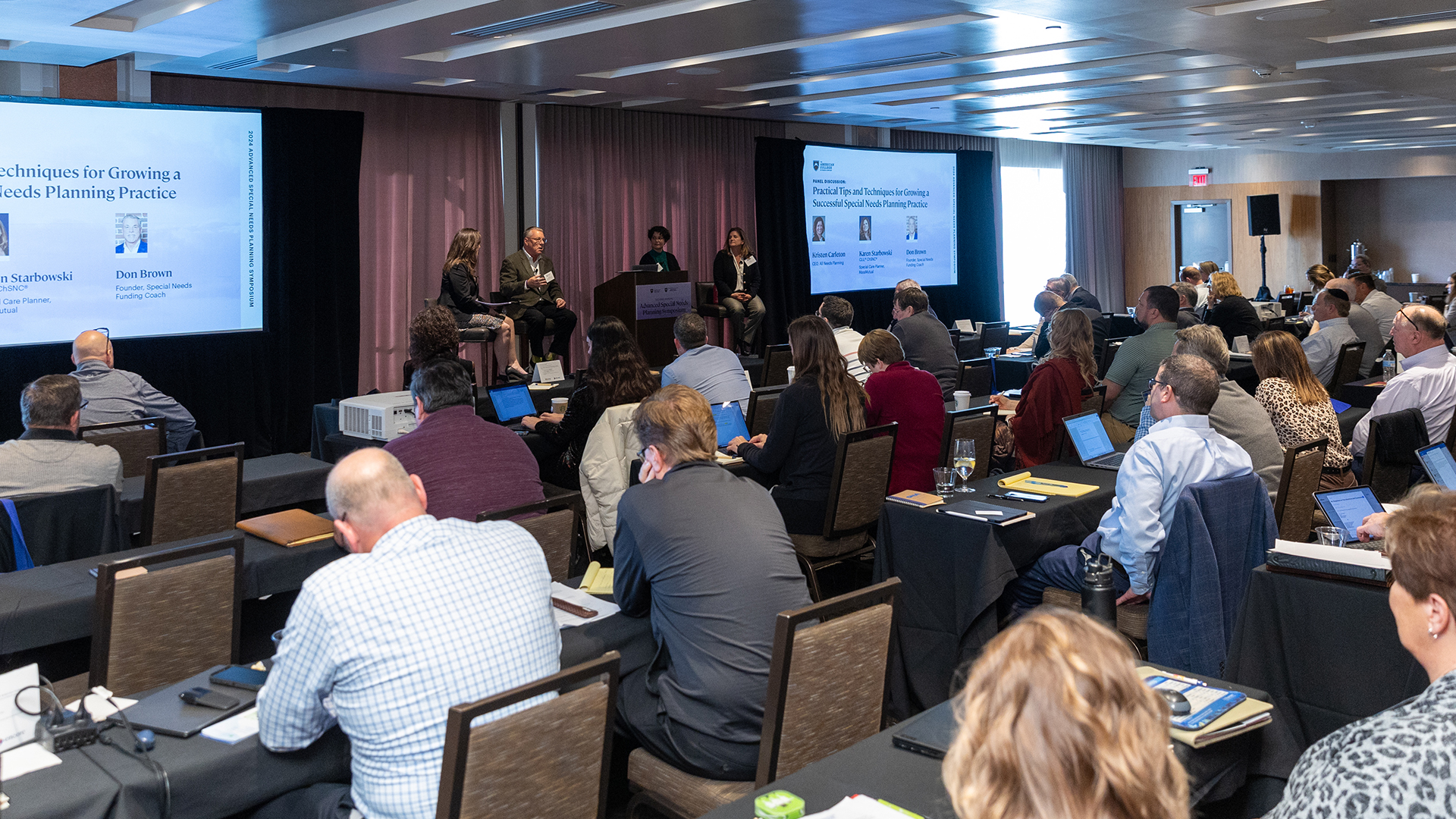About The College News
College News Roundup December 2024
RetireReady | Financial Literacy
December 2, 2024
Based on the findings in The College’s 2023 Retirement Income Literacy Study, this podcast episode dissects the importance of financial literacy and how Americans can enhance their retirement knowledge.
Investopedia | How To Maximize Social Security Benefits
December 3, 2024
Consulting with College Adjunct Instructor Arthur Prunier, RICP®, this article highlights key strategies that individuals approaching retirement can enact to make the most out of their benefits.
Yahoo Finance | "Last-Minute Tax Impacts" You Can Implement Today: Expert
December 3, 2024
Associate Professor of Business Planning and Tax Planning Certified Professional® (TPCP®) Program Director Sophia Duffy, JD, CPA, AEP® shares tips on how to proactively plan for potential tax policy changes in the new year.
Financial Planning | Side Hustle Nation: How To Help Self-Employed Clients with IRS Rules
December 4, 2024
In this article, Associate Professor of Business Planning and TPCP® Program Director Sophia Duffy, JD, CPA, AEP® discusses the intricacies of navigating income tax for self-employed clients.
TradeTalks | Potential Tax Legislation in 2025 and 2026 and What Investors and Financial Advisors Should Be Considering
December 5, 2024
Professor of Practice in Tax Planning Jeffrey Levine, CFP®, CPA/PFS, ChFC®, RICP®, CWS, AIF, BFA™, MSA, Associate Professor of Business Planning and TPCP™ Program Director Sophia Duffy, JD, CPA, AEP®, and Wealth Management Certified Professional® (WMCP®) Program Director Michael Finke, PhD, CFP® join TradeTalks host Jill Malandrino to talk tax legislation changes in the new year and how to plan long-term.
InvestmentNews | Introducing a New Tax Planning Certification for Advisors
December 5, 2024
Sophia Duffy, JD, CPA, AEP®, associate professor of business planning and TPCP® Program director, sits down with InvestmentNews host Greg Greenburg to highlight how The College’s new Tax Planning Certified Professional® (TPCP®) Program can strengthen advisors’ tax planning toolkits.
Financial Advisor | Index Funds Are Popular, But They're Not All Alike, Advisors Say
December 6, 2024
In this article, WMCP® Program Director Michael Finke, PhD, CFP® discusses the best way to utilize index funds and how recent research might push investors to reconsider their current strategies.
Church Executive | How To Vet a Financial Advisor
December 9, 2024
This article outlines what a client should look for in a financial advisor, including specialized financial and retirement planning through The College’s Chartered Financial Consultant® (ChFC®) and Retirement Income Certified Professional® (RICP®) designations.
ThinkAdvisor | Meet the 2024 Luminaries Winners
December 12, 2024
The College was honored as the recipient of the Luminaries Advisor Education Award for Thought Leadership and Education at the 2024 Luminaries Awards. Associate Vice President of Centers Strategy and Operations and Managing Director of the American College Center for Special Needs Joellen Meckley, JD, MHS, ChSNC® was one of many honorees as a Luminary with a Heart.
Fortunly | Finance Certifications to Boost Your Resume
December 15, 2024
This article lists the top certifications that individuals can pursue to enhance their career in financial services, including the College’s ChFC® program.
Yahoo Finance | Bitcoin Clears Another Record: Is Now the Time to Invest?
December 16, 2024
As the price of Bitcoin continues to skyrocket, WMCP® Program Director Michael Finke, PhD, CFP® warns against giving in to the fear of missing out and instead advises those looking to invest to look before they leap.
Gwinnett Daily Post | LAKO: Retirement Literacy Gap: Why Planning Is More Important Than Ever
December 18, 2024
In this article, columnist William Lako, CFP®, considers the implications of the College’s 2023 Retirement Income Literacy Study findings, looking specifically at the results involving investment literacy.
Global Banking & Finance Review | Guidance Based on Education & Collaboration: How Richard C. Peck Consulting and The Philanthropy Guy Empower Nonprofits
December 19, 2024
This article spotlights the philanthropy efforts of FinServe Network Ambassador Richard C. Peck, CFP®, ChFC®, CAP® , including the College’s Donor-Advised Funds (DAF) Professional Certificate program.
MSN | Reverse Mortgages: A Reliable Tool for Modern Retirement
December 20, 2024
College Adjunct Instructor of Retirement Income Don Graves, RICP®, debunks the misconceptions around reverse mortgages and summarizes the history of issues and reforms behind the retirement tool.
Author
Subscribe to Newsletter
Related Posts
2025 Conference of African American Financial Professionals
About The College Press
New Campaign to Elevate Financial Designations

KING OF PRUSSIA, PA – January 6, 2025 – To communicate the specialized expertise behind designations earned and maintained at the nation’s leading accredited institution for financial education, The American College of Financial Services has partnered with Big Com, a full-service marketing and advertising agency, to develop a consumer awareness campaign.
“Americans have complex and unique financial situations, and the financial life they want to live is just as complex and unique. While clients are mostly satisfied with the investment management and broad financial planning services they receive, research tells us that satisfaction erodes as specialized services are needed,” said George Nichols III, CAP®, president and CEO of The College. “Consumer confusion over the myriad of designations makes it difficult for them to discern a generalist from a specialist. To fulfill our mission to uplift the profession and benefit society, we must do more to share what our credentials mean, and amplify the designees who hold them.”
To achieve this goal, Big Com and The College will spend the next eight months conducting research, talking with designees, assessing consumer sentiment, and executing a campaign that helps consumers cut through the confusion and better align their goals with a professional’s, or their team’s, expertise. Big Com will be on the ground at The College’s flagship educational experience, Horizons, in March to hear from designees about how they view their designations, how they discuss them with clients, and what matters most to them.
The campaign, set to launch to the public this fall, is one of several benefits available to College designees in good standing.
A webcast will be held in early 2025 to review all the new Professional Recertification Program (PRP) benefits introduced over the past 12 months and answer any questions about the campaign, including the re-designed website, www.YourAdvisorGuide.com, where clients can search for professionals who have the expertise they need.
“The profession has made significant strides in increasing professional competence, credibility, and trust since our founding nearly a century ago. Having baseline educational standards is important, as it is in any profession. Yet, as client needs have grown more complex, expectations are not always being met in retirement, estate, tax, philanthropy, and other areas. We believe an additional layer of understanding related to specialized knowledge and service offerings, similar to the specializations found in professions like medicine, will help clients have more clarity, greater confidence, and make well-informed decisions when it comes to selecting the right financial professional or team,” said Jared Trexler, senior vice president and chief marketing and chief strategy officer.
“Big Com has a distinguished track record of working with disruptors in various sectors. We are confident they can help us move the needle in raising awareness of how College designations set financial professionals apart—and the value proposition these committed pros can deliver to American families.”
###
ABOUT THE AMERICAN COLLEGE OF FINANCIAL SERVICES
Founded in 1927, The American College of Financial Services is the nation’s largest nonprofit educational institution devoted to financial services professionals. Holding the highest level of academic accreditation, The College has educated over 200,000 professionals across the United States through certificate, designation, and graduate degree programs. Its portfolio of applied knowledge also includes just-in-time learning and consumer financial education programs. The College’s faculty represents some of the foremost thought leaders in the financial services industry. Visit TheAmericanCollege.edu and connect with us on LinkedIn, Instagram, Facebook, and YouTube. Discover all the ways you can expand your opportunities with us.
ABOUT BIG COM
Big Com is a full-service marketing and advertising agency based in Birmingham, Alabama, dedicated to helping national brands connect with consumers. With a unique approach grounded in an earned media mindset, Big Com leverages its PR and creative advertising expertise to build meaningful, lasting relationships between brands and their audiences. For more information, visit www.bigcom.com.
Contacts:
Sarah Tremallo
908-967-0381 / Stremallo@jconnelly.com
Jared Trexler
610-526-1268/ jared.trexler@theamericancollege.edu
Ethics In Financial Services Insights
Unlock the Power of Trust with The Trust Certificate Program

The Trust Certificate Program equips financial services professionals with the tools needed to overcome these hurdles and develop skills to address future complexities as a resilient, effective leader. Through this program, you’ll become a trusted partner to financial advisors, identify and overcome barriers to trust, master client trust, and navigate industry trust-related challenges.
This program goes beyond theory, applying frameworks developed by the American College Cary M. Maguire Center for Ethics in Financial Services to help participants build deeper connections, address barriers to trust, and create trust-based relationships that drive long-term success.
Participants can choose between two course offerings:
Strategies for Building Trust: A Practice-Based Certificate Program TRST 101
- Live program designed for financial professionals, advisors, and leaders from various financial services institutions
- Program provides six hours of fully remote education, with CE credits
- Next Cohort: June 13, 20, 27, 11:00am-1:00pm EST
- Available for open enrollment via The College’s student enrollment portal
Advanced Strategies for Building Trust: A Practice-Based Certificate Program TRST 100
- Live program tailored for home office leaders at a single company
- Provides 10 hours of education, including a capstone project, with CE credits
- Delivered on-site, hybrid, or fully remote
- Delivery dates tailored to the company calendar
The Center for Ethics in Financial Services is dedicated to raising the level of ethical behavior in the financial services industry – this program is your best investment in a thriving and successful future! Enroll today and unlock the power of trust.
More from The College
- Learn more about the Center’s Trust Certificate Program including enrollment information.
- Access information on the Center’s research on trust's role in financial services.
About The College Representation Insights
Cultivating a Community of Commitment

Held for the second consecutive year, the Advanced Special Needs Planning Symposium brought together professionals dedicated to working with special needs clients for two days worth of advanced learning sessions meant to improve participants’ understanding of special needs, disability, and long-term care planning. According to the managing director of the American College Center for Special Needs Joellen Meckley, JD, MHS, ChSNC®, the event served as a positive sign of The College’s support for advanced continuing education for practitioners in the field that have dedicated much of their practice and lives to serving this unique group of individuals.
Commitment to Quality Education
After initial opening remarks, the Advanced Special Needs Planning Symposium transitioned into its educational sessions. Featuring a number of high profile speakers, these presentations offered attendees insights into advanced techniques to assist special needs clients focused in areas such as tax, care management, housing solutions, advocating for clients, and more. When asked about the value of these sessions, Meckley stated, “People walked out with new tools, tips, techniques, (and) professional connections that they can incorporate into their practice immediately.”
The first day of the symposium ended with a networking reception that allowed the conference’s attendees an opportunity to meet and discuss the day’s events as well as the unique idiosyncrasies of their practice. Meckley, when reflecting on this networking event, stated that it brought a lot of value to attendees by bringing together seasoned professionals who may live across the country from one another to talk about their highly specialized practice and share advice with one another. It also served as a major learning opportunity for newer practitioners, offering them the chance to establish personal connections with veteran advisors. Meckley stated, “That kind of thing always goes hand in hand with this type of planning. It’s always a team effort.”
A Deep Dive on ABLE Accounts
The second day of the symposium kicked off with a learning session led by Jerry Hulick, a principal with Caring Consulting Group, and Eric Ochmanek, program director of ABLE Today. The two provided attendees with a detailed presentation on ABLE accounts and how financial planners can use these accounts to the benefit of their special needs clients. Learners received in-depth information on strategies for leveraging ABLE accounts, updates on legislation regarding these accounts, and specific tips and techniques that could help them make use of the information they were gaining in their own practices.
Closing the Symposium
Meckley shared some encouraging thoughts as the second day drew to a close.
"A lot of people here are very passionate about what they do and they have this personal sense of meaning in what they do. It's a unique room to be in."
- Joellen Meckley JD, MHS, ChSNC®
By serving this highly specialized group of practitioners who served a very specific client base, Meckley believes The College is making important strides in the field of special needs planning. “We’re…the only conference that I’m aware of that is specifically designed for financial professionals who are practicing (special needs planning)…There’s other education opportunities out there for them, but we are really kind of carving out a path here that is unique to The College.”
By allowing participants to take part in such a gathering, The College demonstrated a strong commitment to the specialized knowledge it touts as the backbone of their educational offerings. By helping experienced professionals become even better at what they do through highly specialized knowledge, The College makes good on its mission to improve society for the betterment of all Americans.
To learn more about The College’s efforts in the special needs community, visit the Center for Special Needs and the Chartered Special Needs Consultant® (ChSNC®) pages.
Representation Insights
December Highlights from the Military Center

Thank You for Supporting the Military Community
To all supporters of the American College Center for Military and Veterans Affairs,
I wanted to take this opportunity to sincerely thank you for your dedication and unwavering commitment to the military community again this year. The impact and advancement of our mission would not have been possible without your support.
A special thank you to our Center Founding Partner and sponsor Penn Mutual and Advisory Council.
We look forward to the continuation of our work and expansion of our initiatives in 2025.
I wish you and your families happy holidays and ask that you keep those currently serving our country in your thoughts and prayers during the holiday season.
Very Respectfully,
Phil Easton
Managing Director, The American College Center for Military and Veterans Affairs
Attending AUSA’s 2024 Annual Meeting and Exposition
From October 14 through 16, staff from the American College Center for Military and Veterans Affairs attended the Association of the United States Army’s (AUSA) Annual Meeting and Exposition in Washington, D.C.
Attending for the first time, the Center for Military and Veterans Affairs was one of numerous exhibitors with Your Next Mission, a program initiative that helps veterans, transitioning services, and their families find employment.
Throughout the conference, staff had the opportunity to speak with numerous active duty, guard and reserve members, veterans, and spouses of the Army about the Center for Military and Veterans Affairs’ scholarship program and career services, detailing the benefits available to those transitioning out of the military and into civilian life with the goal of a career in the financial services industry.
The Center for Military and Veterans Affairs’ stewardship manager, Angelica Marino, also had the opportunity to be featured on Wreaths Across America Radio and inform listeners of initiatives and impact to the military community.
Honoring Heroes With Major General Suzanne Vautrinot
On November 14th, Major General Suzanne Vautrinot, USAF (Ret.), 2024 Soldier-Citizen Award Recipient, joined the American College Center for Military and Veterans Affairs for a webcast in honor of Veterans Day to share personal stories of service, sacrifice, and selflessness from her 31-year career.
She began by discussing how her service shaped her perspective on leadership and sacrifice. “Leadership is sacrifice, being there for the nation as a higher calling. Being there whenever they ask. The military assigns you to their needs and they ask you to go places that may not have been first or even last on your list. It is a sacrifice that gives back every single day.”
She continued by discussing her mentors and how the sacrifices made by veterans have shaped the identity of our nation. “You’re all into the bigger idea, something bigger than themselves. The greater good is international. We go around the world and protect their freedom. They are looking at what we created as veterans.”
The webcast continued by highlighting the skills, leadership qualities, and dedication developed through military service and how these attributes translate into successful careers in finance.
“Lifelong learning, professional development, ability to respond to a crisis, resilience, dedication, helping others, sacrifice—all of these attributes and skills from the military are a perfect fit for the industry.”
The webcast concluded with Major General Vautrinot addressing community engagement and cultural awareness of financial organizations. “Everyone in the industry is there to create a community. You had that community in the military. We are brothers and sisters at arms, and everyone is looking for that community.”
Military Center Featured at Alumni & Volunteer Breakfast
On November 8, the American College Center for Military and Veterans Affairs managing director Phil Easton joined fellow leaders of The College’s Centers of Excellence in a dynamic panel discussion tackling a pressing issue shaping the future of our industry: how to effectively engage the next generation of financial advisors and the impact of mass retirement within the financial services sector.
Homecoming 250 Navy Marine Corps
Homecoming 250 Navy Marine Corps is a 501(c)(3) non-profit dedicated to celebrating the 250th anniversary of the U.S. Navy and U.S. Marine Corps in their birthplace – Philadelphia and the Delaware River – as a grand opening event of the Semi quincentennial of the United States.
“The Navy and Marine Corps were both founded in Philadelphia,” said George Leone, President of Homecoming 250. “Both Philly and Camden were instrumental in building and deploying ships in the Revolutionary War and over the next 200 years.” Homecoming 250 wants to honor that history, support those who serve, salute our veterans, and remind us of what unites us.”
For the Navy 250th, Homecoming 250 plans to assemble historical and current ships for touring. For the Marine Corps 250th, Homecoming 250 plans to gather ships important to the Corps, host the 100th Marine Corps Ball where the first ball was held, and celebrate at the site of Tun Tavern, the birthplace of the Marines. Homecoming 250 is bringing these celebrations to Philadelphia, Camden, and the Delaware River to support our military, salute our veterans, and educate the public about the role of the Navy and Marines to defend America and freedom.
Festivities for the 250th anniversaries begin October 9 and run through October 16, 2025 [Homecoming 250 Navy Marine Corps, Oct. 2, 2024, “Homecoming 250 Navy Marine Corps Announces Epic 250th Birthday Celebration of the Navy & Marine Corps in Fall 2025 [Press Release]].
Thank You From Our Scholars
The American College Center for Military and Veterans Affairs received a thank you recently from one of our scholars. With his permission, we have made the letter available for you to read below.
Dear American College of Financial Services Center for Military and Veterans Affairs,
I cannot sincerely express my gratitude and excitement to have been selected as a recipient of your scholarship. Your generosity and support mean the world to me, my family, and loved ones.
This scholarship is not simply a financial burden off my back, but better yet, is a beacon of hope that one day I will achieve the goals I set out to achieve and more importantly, to continue to be an inspiration to my family, especially my children.
I come from humble beginnings and now that I’m older and more knowledgeable, I realize that money has never been the problem, but the lack of financial literacy. This scholarship will not only help me become a more prepared and knowledgeable financial services professional but will enable me to do the one thing I always wanted to do…. to help those who need it the most. To spread knowledge and financial literacy to as many people as possible.
Again, thank you for believing in my potential and investing in my education. I promise to make the most of this opportunity and contribute positively to this beautiful place we call earth.
With sincere gratitude,
Gabe Sanchez
About The College News
College News Roundup November 16 30 2024
Financial Advisor | Helping Your Clients Select The Best Retirement Housing Options
November 18, 2024
Associate Professor of Succession Planning Chia-Li Chien, PhD, CFP®, PMP®, CPBC takes a look at how advisors can assist in picking the best living options for their aging clients.
InvestmentNews | More Professional Designations Mean More Success for Women Advisors
November 19, 2024
Lindsey Lewis, MBA, CFP®, ChFC®, managing director of the American College Center for Women in Financial Services, looks at how further education can empower women building careers in financial services.
InsurMark | Permission to Spend: Next Level Retirement Income Planning with Michael Finke
November 20, 2024
Wealth Management Certified Professional® (WMCP®) Program Director Michael Finke, PhD, CFP® speaks in this podcast episode about how advisors and clients can work together to maximize the use of the money they’ve spent a lifetime accumulating in retirement.
Business Insider | What Does a Financial Advisor Do?
November 21, 2024
This article breaks down the various roles a financial advisor can play in assisting their clients, including retirement planning through The College’s Retirement Income Certified Professional® (RICP®) designation.
Kiplinger | Sequence of Return Risk: How Retirees Can Protect Themselves
November 25, 2024
Based on research by College retirement expert and Professor of Practice Wade Pfau, PhD, CFA, RICP®, this article examines how retirees can work with their advisors to ensure the safe and secure drawdown of their assets as they age.
Kitces.com | Enhancing Client Conversations About Charitable Giving: Sample Questions, Scripts, and Tools for Better Engagement
November 27, 2024
College Adjunct Professor Kathleen M. Rehl, PhD, CFP®, CeFT® Emeritus, discusses how advisors can begin conversations on charitable giving with their clients.
Financial Advisor | Is The Dream Of A Florida Retirement Over?
December 1, 2024
In the aftermath of severe hurricanes striking Florida, Professor of Practice Steve Parrish, JD, RICP®, CLU®, ChFC®, AEP® examines whether the state is still a prime place for retirees to move.
Philanthropic Planning Press
New Donor Advised Fund Professional Certificate Program

KING OF PRUSSIA, PA – January 2, 2025 – The American College of Financial Services is excited to announce the creation of its Donor-Advised Fund (DAF) Professional Certificate Program. This program aims to empower staff at DAF-sponsoring organizations to create a shared standard of knowledge and competency for the DAF industry. Registration is now open for the inaugural program, which will be held in-person at The Adolphus in Dallas, Texas, from April 8-9, 2025.
This industry-first certificate program will offer a complete picture of day-to-day DAF program management and include sessions on the evolving philanthropic landscape, understanding motivations to give, identifying assets to donate, managing gift acceptance, effective grantmaking principles, investment strategy alignment, building strong relationship management, planning for succession of funds, and DAFs as part of estate planning. The curriculum will include 12 to 15 hours of instruction and valuable networking opportunities.
“Building a shared understanding of DAF management and application ties deeply to The College’s mission of applied knowledge, dating back to our founding in 1927,” said George Nichols III, CAP®, president and CEO of The College. “Our new DAF Professional Certificate Program continues our legacy of standard-setting applied knowledge that takes what’s in a textbook and brings it to life, so DAF professionals can apply this knowledge immediately.”
The College has developed its new DAF Professional Certificate Program in collaboration with four premier sponsors: Fidelity Charitable, National Philanthropic Trust, Vanguard Charitable, and DAFgiving360. These partners bring extensive expertise and resources, ensuring participants gain insights from leading organizations in the field. The program also incorporates guidance from Daylight Advisors and other stakeholders to provide a comprehensive understanding of DAFs and enhance the overall educational experience.
“Investing in education around DAFs is essential for the future of philanthropy,” said Chia-Li Chien, PhD, CFP®, PMP®, Associate Provost, Undergraduate & Graduate Programs. “This program will enhance the skills of DAF professionals but also elevate the entire philanthropic ecosystem.”
The DAF Professional Certificate Program aims to establish a common language and set best practices, ensuring that participants emerge as informed leaders. Upon completion, learners will receive a certificate and a digital badge recognizing them as a DAF Certified Professional.
For more information about the program, please visit www.theamericancollege.edu/DAF.
###
ABOUT THE AMERICAN COLLEGE OF FINANCIAL SERVICES
Founded in 1927, The American College of Financial Services is the nation’s largest nonprofit educational institution devoted to financial services professionals. Holding the highest level of academic accreditation, The College has educated over 200,000 professionals across the United States through certificate, designation, and graduate degree programs. Its portfolio of applied knowledge also includes just-in-time learning and consumer financial education programs. The College’s faculty represents some of the foremost thought leaders in the financial services industry.
Visit the rest of our site and connect with us on LinkedIn, Instagram, Facebook, and YouTube. Discover all the ways you can expand your opportunities with us.
Contact
Sarah Tremallo
908-967-0381 / Stremallo@jconnelly.com
Jared Trexler
610-526-1268 / jared.trexler@theamericancollege.edu
About The College Representation Retirement Planning Podcasts
What’s Next in Lifelong Learning

In this episode of our Shares podcast, Chief Marketing and Strategy Officer Jared Trexler and College President and CEO George Nichols III, CAP® sit down for a wide-ranging discussion on The College’s major accomplishments in 2024, how the financial services industry and higher education are changing, and how The College is moving to meet the moment in 2025 and beyond.
George Nichols III, CAP® currently serves as the 10th president and CEO in the storied history of The American College of Financial Services. Nichols joined The College after a 17-year stint at New York Life, where he held principal roles in sales, P&L, strategic initiatives, and public policy. In 2007, Nichols was named to the company's executive management committee. He also served as executive vice president in the Office of Governmental Affairs. Before joining New York Life, Nichols was the state of Kentucky's first Black insurance commissioner, leading regulation of the state's $10 billion insurance industry through his expertise in health insurance reform and financial services integration. He gained this knowledge through stints as the executive director of the Kentucky Health Policy Board, vice president of marketing for Athena of North America, executive director of product development with Blue Cross Blue Shield of Kentucky, CEO of Central State Hospital in Louisville, and executive assistant to the Commissioner of the Kentucky Department for Mental Health Services.
Nichols has been acclaimed for his efforts to drive transformative change in diversity, equity, and inclusion in the financial services profession and elsewhere. Savoy, a leading Black business and lifestyle magazine, named him among the "Most Influential Black Corporate Executives" twice: in 2012 and 2018; and among the “Most Influential Black Corporate Directors” in 2021. He was named to Forbes' inaugural 2021 edition of "The Culture 50 Champions." Nichols was also honored as one of "The Ten to Watch in 2021" by WealthManagement.com, and in 2022, he won a ThinkAdvisor LUMINARIES award for Executive Leadership, followed by InvestmentNews’ recognition in 2023 for the year’s See It, Be It role model. Additionally, Nichols is the inaugural recipient of the Alonzo Herndon Award by Business Insurance Magazine.
Any views or opinions expressed in this podcast are the hosts’ and guests' own and do not necessarily represent those of The American College of Financial Services.
More From The College
- See More Content from Our President
- View Our Strategic Priorities
- Enroll in Our Tax Planning Certified Professional® (TPCP®) Program